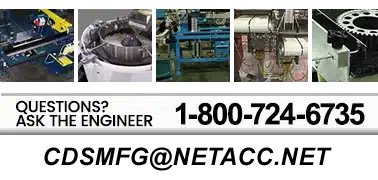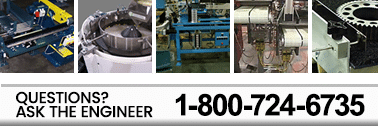What is a Centrifugal Feeder?
A centrifugal feeder consists of a conical central rotor (disc) situated within a circular, stationary, or independently rotating bowl wall.
- Operation: Parts are loaded into the center of the bowl. An electric-driven motor spins the rotor at high speeds (often 50 to over 1000 RPM).
- Mechanism: This rotation generates centrifugal force, which propels the parts outward toward the bowl’s perimeter.
- Orientation: As the parts move to the outer edge, they encounter precision tooling, wipers, and gauges mounted on the circular rim. This tooling mechanically manipulates the parts, sorting and orienting them into a single-file stream.
- Discharge: Once oriented, parts are discharged from the bowl onto a conveyor or track for the next processing step.
Centrifugal feeder bowls are available in sizes ranging from 6 inches to 54 inches in diameter, scaled to the required volume and part size.
Centrifugal Feeders: The Apex of High-Speed Parts Handling
Centrifugal feeders, often referred to as rotary feeders or descramblers, are specialized automated systems built for sheer speed and gentle handling. Unlike traditional vibratory feeders that use angled vibrations to “hop” parts forward, centrifugal feeders harness rotational force to achieve unparalleled throughput rates in manufacturing.
CDS LIPE manufactures these high-performance machines to serve industries where production targets demand both rapid material delivery and uncompromising precision, such as pharmaceutical, medical, and high-volume consumer packaging.
Why Centrifugal Feeders are Premier for High-Volume Lines
Centrifugal feeders are the go-to solution when speed and consistency are the non-negotiable requirements of an assembly line.

A centrifugal feeder consists of a conical central rotor (disc) situated within a circular, stationary, or independently rotating bowl wall.
- Operation: Parts are loaded into the center of the bowl. An electric-driven motor spins the rotor at high speeds (often 50 to over 1000 RPM).
- Mechanism: This rotation generates centrifugal force, which propels the parts outward toward the bowl’s perimeter.
- Orientation: As the parts move to the outer edge, they encounter precision tooling, wipers, and gauges mounted on the circular rim. This tooling mechanically manipulates the parts, sorting and orienting them into a single-file stream.
- Discharge: Once oriented, parts are discharged from the bowl onto a conveyor or track for the next processing step.
Centrifugal feeder bowls are available in sizes ranging from 6 inches to 54 inches in diameter, scaled to the required volume and part size.
CDS LIPE: Engineered for Precision and Compliance
As a premier manufacturer, CDS LIPE focuses on integrating this raw speed with industry-specific quality requirements:
- Sanitary Compliance: CDS LIPE Centrifugal Feeder Bowls are offered in USDA approved design and industrial grade design, making them the centrifugal feeder of choice for the food and pharmaceutical industries where hygiene and washdown capability are mandatory.
- Integrated Vision: Systems can be paired with integrated programmable vision technology to perform high-speed inspection of parts (like caps, bottles, or medical plungers) at the maximum feed rate, ensuring 100% quality without sacrificing speed.
- Custom Tooling: Each centrifugal feeder is custom tooled to ensure precise handling and orientation, enabling the machine to effectively feed challenging components like medical parts, cosmetic closures, and electrical components.
For more on this and other CDS Lipe engineered products contact us today!





